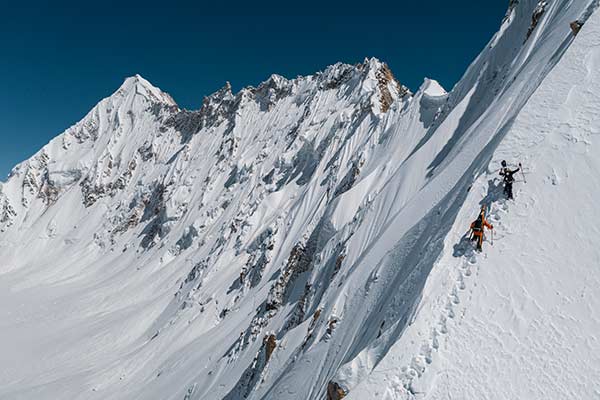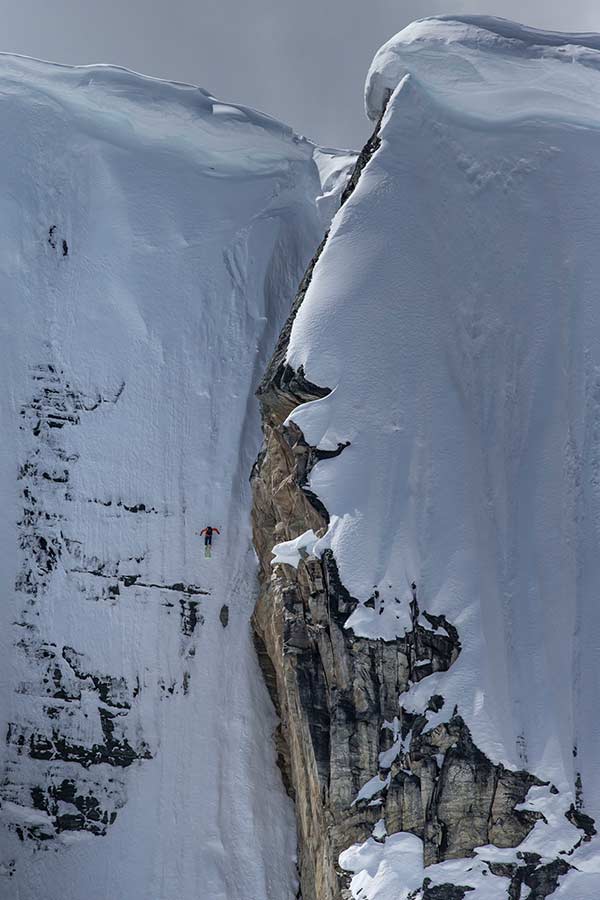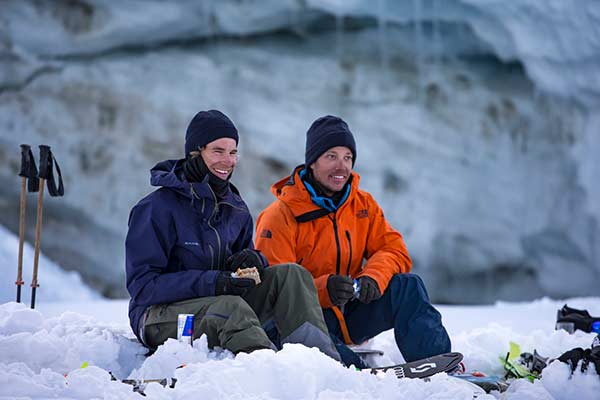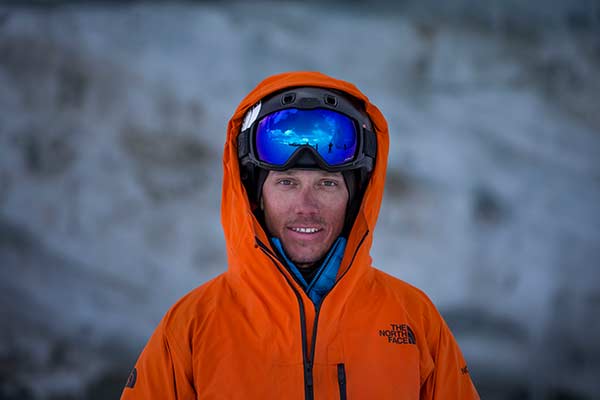Sam Anthamatten has mastered several types of alpinism at the highest level. With his Valais colleague Jérémie Heitz, he has climbed six thousand meters in freeride style.
As a Sam anthamatten and Jeremiah Heitz set off for Artesonraju, a six-thousander in the Peruvian Andes, the conditions look promising. But at the summit the weather changes. Wind picks up, visibility worsens. Anthamatten goes ahead and soon finds out that under these circumstances fast skiing is no longer an option. The mountainside has turned into an icy abyss. He radios an urgent warning to Jérémie, who is still at the summit: "No big turns!"

Disappointed, both of them slide down the flank, the skis repeatedly scraping on the bare ice. The camera team follows. Suddenly there is a scream. One of the photographers loses his footing, rolls over and falls unconscious down the icy wall. Jérémie has the presence of mind to bring himself into the lifeless body's trajectory and stop it. Only the edges of his skis rammed into the ice keep them from falling further into certain death. A complicated rescue operation follows, in which the team manages to bring the seriously injured man down into the valley on an improvised rescue sled. He survived.
These are disturbing images, the viewers experience the crash and the emotions of the protagonists up close through GoPro recordings. On the evening of the Swiss premiere of “La Liste – Everything or Nothing”, they flicker across the huge screen of the Imax cinema in Lucerne, before the eyes of an audience that probably expected more of a spectacle. That too is delivered later in the film, but it's the dramatic prelude that stays.
More nervous in front of an audience than on the mountain
Anthamatten is now sitting in the cozy kitchen of his chalet on the outskirts of Zermatt, tastefully combining tradition and modernity. Warm wood surrounds the dark stone kitchen, and an iron staircase leads to the open attic. "As a trained carpenter, the roof structure was of course important to me," says Anthamatten, looking up. He built almost everything himself. Events in Paris, Lucerne and Salzburg are behind him. The film lured everyone with status and name into the cinema halls, but Anthamatten remained down-to-earth and modest in the middle.
He was particularly nervous in front of his home crowd, he said in Lucerne. In the film, he thunders down mountain slopes with stoic composure, jumps over crevasses and drives away from sliding masses of snow. The 1,68 meter tall man from Zermatt is not one who exaggerates himself - although he is the most perfect all-rounder that alpinism currently knows. He is one of the world's best freeriders, before that he made a name for himself as a top alpinist. 40000 people follow him on Instagram, he has contracts with the most prestigious brands. If you ask about his job, he says: "Mountain guide." He stood there with customers more than seventy times Matterhorn.
“You go into the mountains yourself and you come down again yourself.”
Sam anthamatten
He grew up in Zermatt, but mountaineering was not born to him. Together with his brothers, he experiences a childhood that includes mountain sports in the form of skiing and hiking. Everything else he worked out himself with his older brother Simon. The "Anthamatten messengers" became a household name in the climbing scene even before they grew up.
Whether on rock, ice or mixed terrain: they set standards everywhere. They go into the mountains as they see fit: always on demanding routes with a high degree of personal responsibility. Once they have to alert the rescue when they get into the night. The event shapes them, because they know: "You go into the mountains yourself and you come down again yourself."

For their first Matterhorn ascent, the brothers choose the Gogna route, a challenging line through the north face that has rarely been repeated since the 18s. The second time they reach the Matterhorn after a first ascent. The parents are only partially informed. They only find out about it when they pat the boys on the back in the village. Then the father asked why he only found out about what we were doing in a roundabout way. "We wanted to prevent our parents from worrying while we were out," says Anthamatten. At the age of XNUMX, he climbs up to the Hörnlihütte alone with his skis, he wants to climb the east face of the Matterhorn. The mother whistles him back on the phone, he obeys without hesitation.
"Freeriding is about speed and dynamics, I had to realize that first."
Sam anthamatten
Simon is training to be a mountain guide, Samuel follows him. At the age of 23, he takes customers to the Matterhorn, and the savings are invested in expeditions. Wherever the two brothers show up, they leave their scent mark. The 1000 meter wall of the infamous El Capitan in California they climb ten different routes in just one month. If it's too hot during the day, they climb at night. In the Himalayas they manage the first ascent of the Jasemba South Face, in Alaska they set an unintentional speed record Moonflower Buttress on. Her great strength is being guided by her own convictions without running blindly towards ruin.
Back flip, 360 degree spin
Rather by coincidence, Samuel started a freeride contest in 2009 and did poorly, as he says himself: "I knew I could do better." He competes in other competitions, catches up with the competition and immediately receives a wildcard to start on the Freeride World Tour. It's the highest league, with ten thousand spectators following the spectacular final in Verbier. "Mountaineering, where I came from, is relatively static," says Anthamatten. "Freeriding is about speed and dynamics, I had to realize that first."
Once he climbs back up after the competition, analyzing a jump made by others while he thought landing on rocky terrain was too dangerous. Since then he has also been a lord of the air, flying far and precisely, sometimes with a backflip or a 360-degree turn. Already in his second year of competition he is on top of the podium and in the final showdown in Verbier he even fights for the overall victory of the World Tour. Samuel becomes Sam.
"Actually, you should transfer the aggressive driving style that is practiced on the tour to the high mountains, where alpinist laws apply instead of competition rules."
Sam anthamatten
After a few years, however, he has the feeling that he is not getting anywhere. He feels that his personal development cannot take place in a competition format trimmed for show. "Every time I was at the start, the surrounding mountains interested me more than the competition face," he recalls. The thought that matured in him: "Actually, the aggressive riding style practiced on the tour should be transferred to the high mountains, where alpinist laws apply instead of competition rules."

Together with Jérémie Heitz, he implemented this ideal in 2015 on the local four-thousanders. Where skiing used to take place (if at all) in the style of controlled cross turns, the two friends align their skis in the fall line and master huge differences in altitude in just a few turns. They reach speeds of over 100 kilometers per hour and jump over glacial avalanches.
"It was as if the mountains were telling us that we should now slowly disappear."
Sam anthamatten
"Setting the bar even higher and going to the six-thousanders in Peru and Pakistan was an experiment," emphasizes Anthamatten, who was motivated but also skeptical about the venture. “After the unsuccessful start on Artesonraju we had to go back to what is realistic." During the conversation, it becomes clear that the photographer's accident had a lot on his mind. Still, he didn't think about giving up. The film shows another expedition to Pakistan, where the descent of the Laila Peak also does not work as planned. When they finally find ideal conditions in a sheltered valley basin, the mountains seem to be forgiving after all.
However, they start their journey home with mixed feelings after an avalanche happened before their eyes - only hours after Anthamatten had still climbed the steep slope. "It was as if the mountains were telling us that we should now slowly disappear," he sums up. That makes you think.
Anthamatten lets it be known that he will continue to prioritize return over increase. He points to Simon. The older brother, who got him into mountaineering in the first place and was always a role model for him, lives with his family on the lower floor of the chalet and has said goodbye to extreme mountaineering. He is now a heli pilot. The great strength of the Anthamatten brothers is to be guided by their own convictions, without running blindly towards their doom.

That might interest you
- Andreas Steindl with new speed record at the Matterhorn
- The six big north faces in just two weeks - Roger Schäli in an exclusive interview
- World record: Mollie Hughes with solo ski expedition in Antarctica
Do you like our climbing magazine? When we launched LACRUX, we decided not to introduce a payment barrier. It will stay that way, because we want to provide as many like-minded people with news from the climbing scene.
In order to be more independent of advertising revenue in the future and to provide you with even more and better content, we need your support.
Therefore: Help and support our magazine with a small contribution. Naturally you benefit multiple times. How? You will find out here.
+ + +
Credits: Text Dominik Osswald, cover photo and images in the article: Red Bull Content Pool

